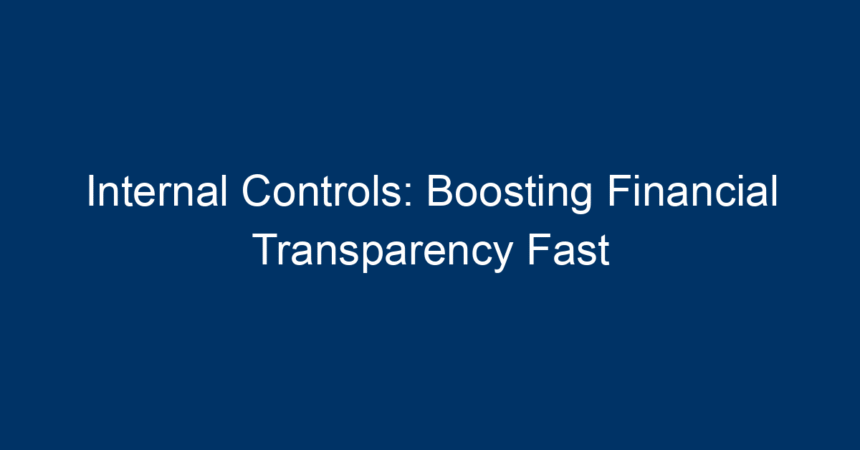In today’s fast-paced business environment, the importance of financial transparency cannot be overstated. Companies face increasing scrutiny from stakeholders, regulatory bodies, and the public. With financial fraud and mismanagement making headlines regularly, the need for robust internal controls has never been more critical. In this article, we will uncover how effective internal controls can enhance financial transparency, safeguard assets, and bolster an organization’s reputation, ensuring that all stakeholders can have confidence in its financial integrity.
Understanding Internal Controls
What Are Internal Controls?
Internal controls refer to the policies, procedures, and systems designed to ensure the accuracy and reliability of financial reporting, compliance with laws and regulations, and effective operations. Why are internal controls essential? They help prevent errors and fraud, ensure assets are safeguarded, and promote operational efficiency.
The Types of Internal Controls
-
Preventive Controls: These are proactive measures intended to prevent errors and fraud before they occur. Examples include segregation of duties, access controls, and physical security.
-
Detective Controls: These controls aim to identify errors or fraud that have already occurred. Examples include audits, reconciliations, and monitoring activities.
- Corrective Controls: These actions are taken to correct identified issues. For instance, if an error is discovered, corrective measures such as refining processes or implementing training can be undertaken.
The Importance of Internal Controls in Financial Transparency
The ultimate goal of implementing internal controls is to ensure financial transparency. By establishing a clear framework for financial reporting and operations, organizations can provide stakeholders with accurate and trustworthy information. This transparency is crucial for building credibility and sustaining long-term relationships with investors, customers, and regulatory authorities.
Benefits of Strong Internal Controls
1. Enhanced Accuracy in Financial Reporting
Robust internal controls create a system where financial data is consistently verified, increasing the accuracy of financial reports. This accuracy promotes trust among stakeholders who depend on these reports for decision-making.
2. Fraud Prevention and Detection
With today’s technological advancements, fraudsters are becoming more sophisticated. Strong internal controls can deter fraudulent activities through a combination of preventive and detective measures. Regular audits and monitoring can help identify discrepancies, ensuring timely intervention.
3. Regulatory Compliance
Organizations must adhere to numerous regulations and standards. Internal controls play a critical role in ensuring compliance with laws such as the Sarbanes-Oxley Act and General Accepted Accounting Principles (GAAP). This not only keeps organizations out of legal trouble but also enhances their credibility.
4. Operational Efficiency
Efficiencies can be realized by streamlining processes through internal controls. By defining clear roles and responsibilities, companies can reduce redundancies and improve workflow, enabling staff to perform their duties more effectively.
5. Increased Stakeholder Confidence
Transparency fosters trust. When stakeholders are confident that an organization employs effective internal controls, they are more likely to engage with it positively. This can lead to increased investment opportunities and improved vendor relationships.
Implementing Effective Internal Controls
Step 1: Risk Assessment
Before implementing internal controls, organizations must conduct a thorough risk assessment. Identifying potential risks related to financial reporting, compliance, and operations helps in tailoring controls effectively.
Step 2: Develop Policies and Procedures
After assessing risks, companies should develop comprehensive policies and procedures addressing identified vulnerabilities. These must be documented clearly to ensure that they are understood and followed by all employees.
Step 3: Assign Responsibilities
Segregation of duties is a fundamental principle of internal controls. Assigning distinct responsibilities to different individuals helps reduce the risk of error or fraud. Each employee should understand their role in the internal control system.
Step 4: Training and Education
For internal controls to be effective, employees must be knowledgeable about the policies and procedures. Regular training sessions can elevate awareness and reduce the chances of unintentional errors.
Step 5: Monitor and Adjust
Internal controls are not static. Companies should continuously monitor their effectiveness through regular audits and feedback. Adjusting procedures based on findings ensures that internal controls remain relevant and effective over time.
Challenges to Implementing Internal Controls
While internal controls offer significant benefits, organizations may face a few challenges:
1. Resistance to Change
Employees accustomed to existing practices may resist adopting new internal controls. Engaging staff in the design and implementation process can alleviate these concerns.
2. Resource Constraints
Smaller organizations may struggle with limited resources. However, implementing even basic internal controls can yield substantial benefits.
3. Complexity of Regulations
Navigating the complex landscape of regulatory compliance can be daunting. Consulting with professionals or utilizing compliance software can ease this process.
Case Studies: Success Stories in Internal Controls
Company A: A Retail Giant
Company A implemented comprehensive internal controls that enhanced its financial reporting processes. By introducing regular audits and monitoring inventory controls, the business reduced discrepancies by 40% within a year. The enhanced accuracy and transparency led to a significant increase in stakeholder trust and investment.
Company B: A Financial Institution
Company B faced challenges with compliance and fraud. After a rigorous risk assessment, they adopted strong preventive controls and employee training programs. Within six months, the organization reported a 30% reduction in compliance issues and an increase in internal satisfaction among employees.
Conclusion: Take Action Today
In conclusion, implementing strong internal controls is vital for enhancing financial transparency. They not only safeguard assets and enhance accuracy in reporting but also build trust among stakeholders. By following the outlined steps—from conducting a risk assessment to continuous monitoring—organizations can foster a culture of transparency that resonates throughout the company.
Actionable Insights
-
Begin with a Risk Assessment: Identify key areas that require immediate attention before implementing controls.
-
Engage Employees: Foster participation from all levels of the organization to ensure buy-in and understanding.
-
Invest in Training: Prioritize ongoing education on internal controls to elevate awareness and compliance.
-
Utilize Technology: Leverage software solutions that can streamline compliance and internal control processes.
- Regularly Review and Improve: Make it a habit to assess and refine internal controls to adapt to changing business and regulatory environments.
By prioritizing internal controls, organizations can not only boost financial transparency but also create a solid foundation for lasting success.



